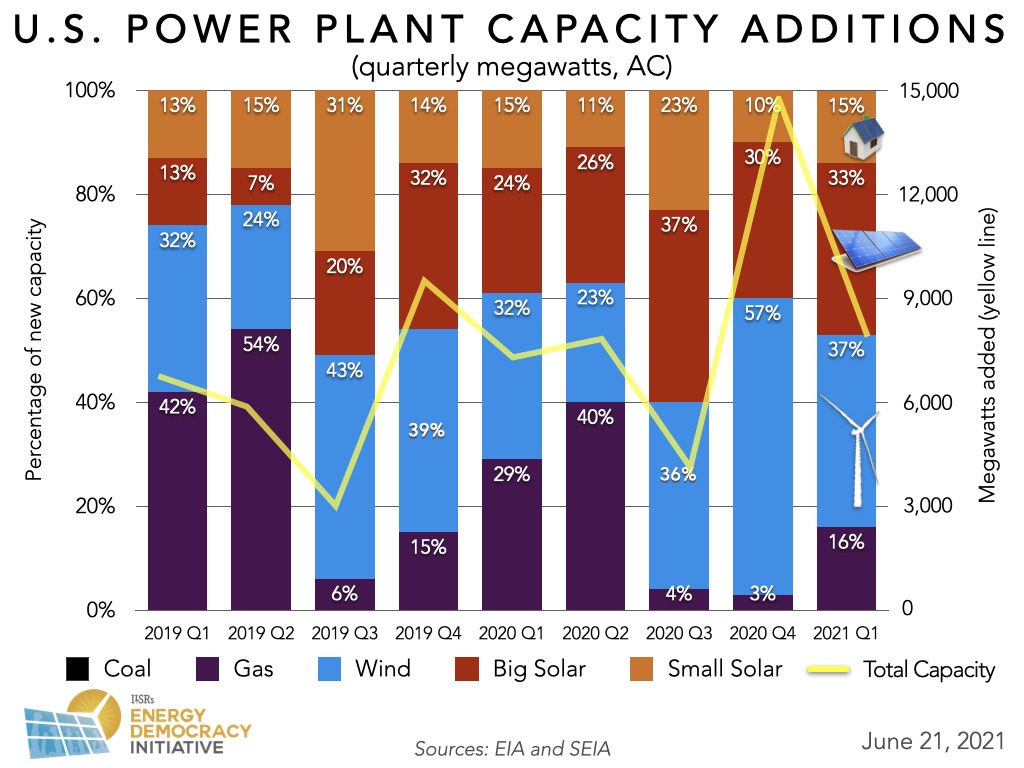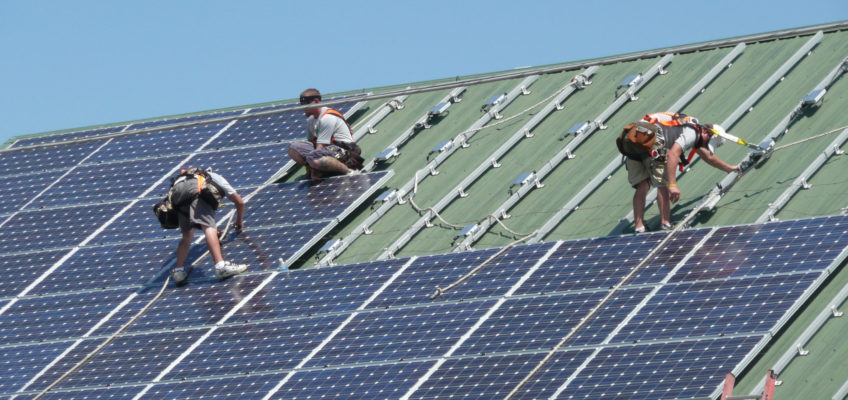The installation of new power generation capacity slowed in the first quarter of 2021 after a monumental previous quarter. Large solar rivaled, but could not quite match wind for the greatest portion of newly installed generation capacity. Still, small and large solar together contributed nearly half of the quarter’s new generation capacity. New gas rebounded slightly after a meager end to 2020, but renewables have still held a majority of new power capacity for 9 of the last 12 quarters.
In the chart below, we illustrate the past two years of new power plant capacity in the U.S., disaggregated by energy source on a quarterly basis.

Solar Starts the Year Strong
Altogether, 3.8 gigawatts of solar were installed this quarter – making the first quarter of 2021 the largest first quarter for solar on record. According to the Solar Energy Industries Association, total installed solar in the United States has now surpassed 100 gigawatts DC.
Utility-scale solar installed this quarter (2.6 gigawatts) was cut nearly by half from capacity added in the last quarter of 2020 (4.5 gigawatts). Added small solar capacity, on the other hand, dipped only slightly from the previous quarter. These figures do not come as a surprise; the fourth quarter is nearly always the strongest quarter for solar as investors rush to take advantage of the waning federal tax credit.
Extending the solar investment tax credit is one of many solar-supportive policy measures proposed in the 30 Million Solar Homes plan.
Community solar subscriptions are increasingly an option for those who cannot install solar on their own roof. New community solar capacity is now included in the “small solar” portion of the figure above, as Wood Mackenzie has started reporting on new community solar capacity. Wood Mackenzie and the Solar Energy Industries Association estimate that 131 megawatts DC of community solar were installed this quarter – though not all of this capacity abides by ILSR’s four principles of beneficial community renewable energy.
Even in the states with supporting policy, interconnection costs and upgrades are holding community solar back from its full potential.
Watch the top state community solar programs progress in our National Community Solar Programs Tracker.
Wind Turbines are Out to Sea
Wind energy took home the largest portion of new generation capacity in the first quarter of 2021 at 37 percent. Nearly three gigawatts of wind were installed this quarter, which is a first quarter record for wind as well.
Wind’s record first quarter followed up a massive previous quarter; there was more wind installed in the fourth quarter of 2020 than all of the generation capacity installed this quarter combined.
One of the many wind projects completed this quarter was the Coastal Virginia Offshore Wind pilot project. This project, owned by Dominion Energy, has been in the works since 2016. It is the second offshore wind farm constructed in the U.S. Given a technology proven in Europe and a supportive Federal administration, offshore wind may soon transform the U.S. wind industry.
Fossil Gas: The Writing’s On the Wall
Nine gas plants came online in the first quarter of 2021. Combined, they have a total capacity of 1.3 gigawatts. This is more gas than was installed in the last half of 2020, but it is still the lowest first quarter for gas since the first quarter of 2018.
In recent news, at the end of June, utility giant Xcel Energy effectively dropped its plan to build a new combined-cycle gas plant in Becker, Minnesota. This decision was made in the wake of unprecedented public comment on the company’s plan and demonstrations by several organizations, including ILSR, that the new gas plant is not a good investment.
Electrification and renewable generation are hot on the heels of fossil gas. The gas industry may buy some time with preemptions on local gas bans, but given the overall direction of the market, it is only a matter of time until gas faces the same fate as coal. By making the right decisions now, economies dependent on the fossil fuel industry and communities most burdened by the fossil fuel industry will not be left behind.
Interested in earlier trends and analysis of new power plant capacity? Check out our archive, illustrating how electricity generation has changed in previous quarters and years.
This article originally posted at ilsr.org. For timely updates, follow John Farrell on Twitter or get the Energy Democracy weekly update.
Featured Photo Credit: U.S. Department of Agriculture via Flickr (CC BY-ND 2.0)





